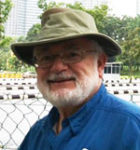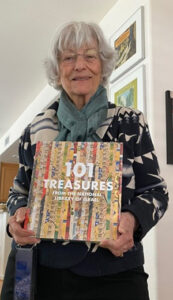101 Treasures From the National Library of Israel. Edited by Raquel Ukeles, Hezi Amiur, Yoel Finkelman, Stefan Litt, and Samuel Thrope (New York and London: Scala Arts Publishers, 2023) Printed and bound in Turkey, 334 pages
By Oliver B. Pollak


RICHMOND, California — I received my Spring 2024 issue of Jewish Review of Books. I have been a subscriber since its founding in 2010. Two of the 15 essays demanded immediate reading: Shai Secunda’s “This Great House” about the new National Library of Israel, and Matti Friedman’s “Homage to Orwell.”
My friend was going to Israel on a StandWithUs mission. I knew he subscribed to JRB because I gave him a gift subscription a couple of years ago, and he renewed it. I texted him to take the JRB in his carry on and read the library story.
Tuesday morning in Jerusalem he and his daughter went to the Israel Museum, but it was closed. The magnificent library, designed by the Swiss firm, Herzog & de Meuron, was across the street. He was so impressed with the exterior, interior and the state of the art robotics that his description jumped from “interesting” to “astonishing.” On the last day of the mission the group toured the library and ate in the dining room.
A few days after my friend returned to Los Angeles, Amazon delivered to my home 101 Treasures From the National Library of Israel. This 343 enamel high-gloss page coffee table book, with about 240 vibrant images, weighed 4.15 lbs., the dust jacket, 1.3 oz. Enclosed was a message from the sender: “A gift for you. Dear Karen and Oliver: This should fill an empty space in your library. Enjoy.” The joke is that my wife has been an unflagging downsizer, in resisting my acquiring new books, but gifts may be different. I thanked my friend, “Never seen Karen so pleased to get a book in an age where she is trying to get them out of the house.”
The year 1892 marks the seeds of the national library. The library moved a few times, was associated with Hebrew University, and is now an independent entity. In 1998 the Bibliothèque Nationale in Paris moved into the modern Bibliothèque Francois Mitterrand, and in London, the British Museum’s library became the British Library in St. Pancras. Libraries were moving away from card catalogs to online catalogues, from couriers and pages to robotics, and digitization. The Knesset passed the National Library Law in 2007. The opening of the National Library of Israel in early October 2023 was delayed due to the outbreak of the Israel-Hamas War.
Each of the 101 treasures has a descriptive text of about 300 words about provenance, origin, and its journey to the Library. As short as the statements are they breathe the emotions of love, inspiration and respect. “Further Reading” provides suggestions for deeper appreciation.
The 101 treasures “all share one essential feature: they allow us to tell great stories.” The books, manuscript, calligraphy, early Hebrew printing, typescripts, maps, posters, photographs, autograph collection, astronomical tables, newspapers, musical scores, vinyl records, postcards, children’s art and literature, the Jewish canon, and other cultural artifacts comprise an intellectual cornucopia.
The narrative is divided into ten categories: Community, Art and Text, Crossing Cultures, Text and Power, Journeys, Marking Time and Space, Friendship, Technology, Writers at Work and Canon. The earliest artifacts are 250 clay bowls from the 5th through the 8th century marked with Aramaic incantations. The 21st century is represented by A. B. Yehoshua (1936-2022).
Jewish book history reads like the exploits of Indiana Jones, searching, mystery and drama. The first treasure, “The Damascus Crowns, 10th-15th Centuries,” were spirited out of Syria by the Mossad in the 1990s. The second treasure, “The Afghan Genizah, 11th-13th centuries,” includes a May 1011 loan transaction. The family archives were discovered in Afghanistan in the early 2000s.
Deltiologists will be pleased with “Theodor Herzl’s Postcards to his Daughter from Jerusalem, 1898” and “Zionist Rosh Hashana Cards, 1902-1960.” The musically attuned will enjoy “Mozart’s Letter to His Wife, Constanze, 1790.” The letter ends, translated into English, “Adieu – I kiss you 1,000 times. Eternally yours, MZT.” He died in December 1791 at the age of 35. Women’s stories appear in “A Premodern Feminist Blessing – Siddur According to the Italian Rite, 1480,” “Women’s Siddur from Salonica (Seder Nashim), ca. 1550,” “Scroll of Esther, 17th-18th centuries,” and a Ketubah.
The editors mention “the chaos and dislocation of 1948,” the Nakba, and salvaging books, manuscripts and periodicals from “empty homes of Palestinian families” which the “Custodian for Absentee Property” placed in the library; they did not include an image.
Books are our friends and foster friendship with others. The accomplishments, the literary corpus of friends whose lives were shortened by disease and self-destruction may be gathered by friends of the departed and find their way to universities, libraries, archives, museums, and auction houses. “Rachel the Poet, ‘My Dead,’ 1931” is about Rachel Bluwstein who died at 40 of tuberculosis. Her friend Zalman Shazar, future President of Israel, found the poem “My Dead” on her desk after she died. The six verse Hebrew poem, translated by A. Z. Foreman, an Ohio State University graduate student, can be found on the internet. “The Walter Benjamin Collection, 20th century” preserved by his close friend Gershom Scholem, went to the National Library in 1984. Benjamin’s suicide appears in Netflix’s “Transatlantic” (2023). “Hannah Szenes’s Last Note, 1944,” was sent to her mother before her execution.
Librarians and archivists will appreciate “Gershom Scholem’s Card File of Zoharic Aramaic, 20th century.” “The Lending Library of the Ghetto, The Vilna Ghetto Archive, 1941-1943” relates the role of Dina Abramowicz (1909-2000) as librarian in the early 1940s. She escaped the ghetto, joined a Jewish partisan group and arrived in America in 1946. I had the honor of meeting her at YIVO in the late 20th century and asking her a reference question.
Isaac Herzog, the President of the State of Israel, wrote the Foreword. The National Library of Israel should be added to tourist itineraries. This book, glorying in the written heritage, is perfect for historically minded friends and Judaica collectors, and for people who you might want to encourage in that pursuit.
*
Oliver B. Pollak, Ph.D., J.D., professor emeritus of history at the University of Nebraska at Omaha, a lawyer, a member of the Institute for Historical Study, and a correspondent based in Richmond, California.